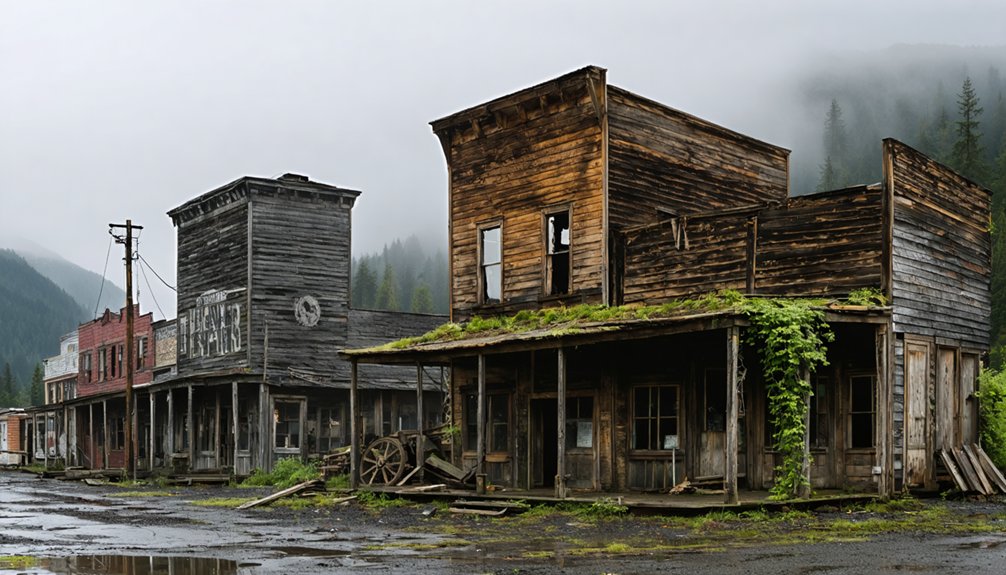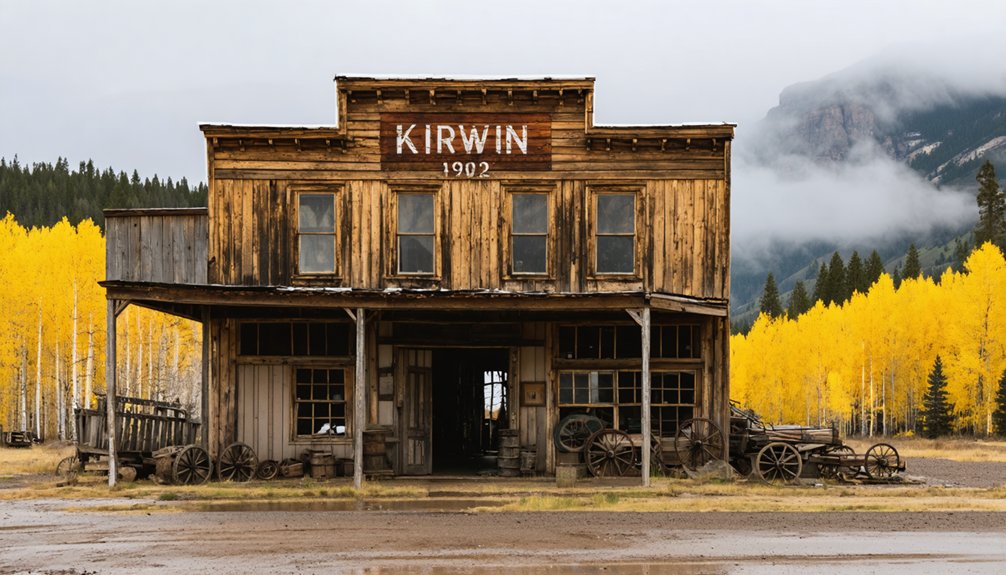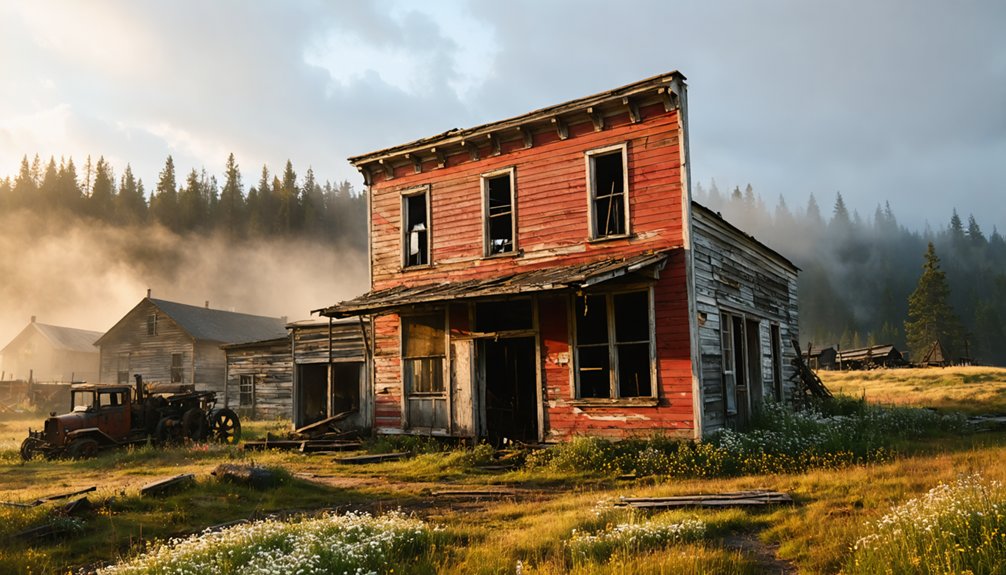The Pacific Northwest offers five compelling ghost towns: Monte Cristo, a mountain mining settlement established after 1889 gold discoveries; Nighthawk, an Okanogan mining district that once attracted 3,000 miners; Shaniko, Oregon’s former wool capital that generated $3 million in sales; Sumpter, whose massive gold dredges extracted millions from 1912-1954; and Bodie, a Ferry County gold town preserved in three historical phases. These abandoned sites reveal fascinating chapters in western frontier development.
Key Takeaways
- Monte Cristo features mining ruins in Washington’s Cascade Mountains with Mystery Pride Mine remnants from an 1889 gold and silver boom.
- Nighthawk preserves an open-air ghost town museum near the Canadian border with extensive mine workings from 1870s silver and lead operations.
- Shaniko, Oregon’s “Wool Capital,” maintains original frontier structures including a hotel, bank, and schoolhouse from its 1900s economic heyday.
- Sumpter showcases Eastern Oregon’s gold rush legacy with a preserved dredge that extracted millions in gold between 1912-1954.
- Bodie in Ferry County contains intact mining structures and visible tailings dumps from industrial-scale gold operations dating back to 1890.
Monte Cristo: Mining Ruins Along Mountain Loop Highway
Nestled in the rugged Cascade Mountains at the headwaters of the South Fork Sauk River, Monte Cristo emerged as a promising mining settlement after the discovery of gold and silver in 1889.
This boom town quickly attracted thousands of miners, with John Q. Barlow surveying a railroad route connecting it to Everett by 1893.
Today, you’ll find fascinating remnants of Monte Cristo’s mining legacy along the Mountain Loop Highway.
Explore weathered mining relics that whisper stories of fortune and failure along the Mountain Loop’s historic corridor.
The Mystery Pride Mine displays underground tramway systems from the 1890s, while other sites reveal mine entrances, rails, and machinery foundations.
Similar to the Woodhouse mine, some locations feature remnants of wooden air pipes that were essential for ventilation in these historic mining operations.
Access requires traveling the 54-mile Mountain Loop Highway, including 14 miles of unpaved road. Visitors can reach the Old Monte Cristo Townsite via a private road located 4 miles east of Barlow Pass.
Despite its promising start, Monte Cristo declined by 1900 as harsh winters, flooding, and tunnel collapses repeatedly disrupted railroad operations, ultimately rendering mining operations unsustainable.
Nighthawk: Okanogan’s Historic Mining District
Located in eastern Washington near the Canadian border, Nighthawk stands as one of Washington state’s most significant mining districts, with claims dating back to the 1870s under Hiram F. “Okanogan” Smith’s initiative.
The area exploded with activity around 1865 when 3,000 miners flocked to Rich Bar on the Similkameen River during a gold rush.
You’ll find Nighthawk’s mining operations were primarily focused on lead and silver extraction, with several concentration mills operating simultaneously during peak production. The most well-known claims included Number One and Eagle among others.
The district features extensive workings, including a 1,770-foot adit at the Nighthawk mine.
Although mining ceased by mid-20th century, with the last mill closing in 1951, many original structures remain standing.
Nighthawk is situated approximately 12 miles west of Oroville, making it accessible for history enthusiasts exploring Okanogan County’s mining heritage.
The preserved ghost town now serves as an open-air museum where you can explore the hotel, schoolhouse, and mining office—tangible connections to Okanogan’s rich mining history.
Shaniko: Oregon’s Preserved Wool Capital
While Nighthawk represents Washington’s mining legacy, just across the state line in north-central Oregon stands Shaniko, once celebrated as the “Wool Capital of the World.”
Shaniko emerged as a planned community in 1900 when businessmen from The Dalles strategically established it as the terminus of the Columbia Southern Railroad.
At the height of the wool trade in 1903-1904, Shaniko achieved unprecedented success:
- Shipped over 2,229 tons of wool and 1.1 million bushels of wheat
- Generated $3 million in wool sales, with one warehouse depositing $1 million in a single day
- Served a vast 20,000 square mile region as Oregon’s largest wool warehouse
Today, this semi-ghost town preserves its frontier heritage with about 30 residents. The name “Shaniko” was derived from the local pronunciation of August Scherneckau, who first settled the area after the Civil War.
You’ll find the original hotel, bank, and schoolhouse still standing—testaments to Shaniko’s brief but spectacular economic boom. The town experienced a rapid decline by 1911 due to two significant fires and competition from a rival rail line.
Sumpter: Gold Rush Legacy in Eastern Oregon
Deep within Eastern Oregon’s rugged landscape, Sumpter emerged as a tribute to the region’s gold rush fervor when prospectors discovered precious metal deposits in 1862.
Originally named Fort Sumter, this settlement evolved rapidly, reaching 2,000 residents by 1897 after railway arrival connected this frontier outpost to civilization.
When easy-access gold depleted, Sumpter history pivoted to industrial mining. Three massive dredges operated between 1912 and 1954, systematically transforming the valley while extracting $10-12 million worth of gold.
Each dredge featured 72 one-ton buckets that processed material with remarkable efficiency. These buckets could process over twenty buckets of gold-bearing earth per minute, separating valuable materials from waste. The dredges operated nearly continuously with three-man crews working shifts to maintain 24-hour operation.
Today, you’ll find one preserved dredge as a state heritage site—a representation of technological innovation amidst challenging terrain.
While Sumpter remains a semi-ghost town, its cultural significance endures through preserved structures that showcase the ambitious spirit of gold extraction pioneers.
Bodie: Ferry County’s Mining Town Frozen in Time
Nestled in Ferry County’s rugged landscape, Bodie stands as one of Washington’s most authentic mining ghost towns, with origins dating back to 1890 when prospectors first discovered promising gold deposits.
Mining techniques evolved from simple extraction of rich ore pockets to industrial-scale operations after the Wrigley Brothers purchased the claim and installed a ten-stamp mill in 1902.
The hands of progress transformed Bodie from simple pickaxe work to industrial efficiency under the Wrigley Brothers’ ambitious vision.
You’ll find Bodie’s history preserved in three distinct phases:
- Early development (1890-1902) yielded $80,000 in gold from initial discoveries
- Peak operations (1902-1916) produced substantial wealth before World War I closure
- Revival period (1934-1944) generated another $280,000 before permanent shutdown
The ghost town remains remarkably intact, with mining structures and tailings dumps containing 3.27 ounces per ton still visible—physical testimony to the freedom sought by frontier miners. By 1896, the settlement had grown to include a restaurant and smithy shop alongside various other buildings essential to community life. Visitors should note that this Bodie is distinct from other locations sharing the same name, requiring careful disambiguation when researching its history.
Frequently Asked Questions
Is It Legal to Take Artifacts From These Abandoned Towns?
No, it’s not legal. You’ll face serious legal consequences for removing artifacts without permission. Artifact preservation laws protect these historical items regardless of how abandoned they appear to you.
Are Any Ghost Towns Accessible During Winter Months?
Yes, you’ll find winter accessibility at several ghost towns. Melmont remains accessible year-round, while Wellington offers snow shed trails. For adventurous ghost town exploration, Garnet provides snowmobile and ski access.
Do Any Towns Have Paranormal Activity or Ghost Stories?
You’ll encounter restless spirits at Monte Cristo and Concrete, Washington. These haunted locations feature documented ghost sightings, with miners’ apparitions in Ruby Townsite and mysterious phenomena in Molson’s schoolhouse, according to visitor testimonies.
Which Town Offers the Best Photography Opportunities?
Molson offers your best photography opportunities with diverse artifacts, pioneer buildings, and a schoolhouse museum. You’ll maximize results using establishing shots from surrounding viewpoints, then capturing intimate details through window reflections.
Are There Guided Tours Available at Any Locations?
Yes, you’ll find limited guided experiences at Monte Cristo, Washington and during special events in Claquato. Most sites offer self-guided tours with interpretive signage rather than regular commercial tour availability.
References
- https://en.wikipedia.org/wiki/List_of_ghost_towns_in_Washington
- https://dot.ca.gov/-/media/dot-media/programs/environmental-analysis/documents/ser/townsites-a11y.pdf
- http://pnwphotoblog.com/ghost-towns/
- https://en.wikipedia.org/wiki/Wikipedia:WikiProject_Ghost_towns
- https://stateofwatourism.com/ghost-towns-of-washington-state/
- https://m.dresshead.com/files/scholarship/Documents/Ghost_Towns_Lost_Cities_Of_The_Old_West_Shire_Usa.pdf
- https://www.rvoutwest.com/episodes/13-ghost-towns-across-the-pacific-northwest
- https://www.youtube.com/watch?v=PO7B-vvx9WE
- https://www.nationaldaycalendar.com/lists/12-oregon-ghost-towns
- https://en.wikipedia.org/wiki/Ghost_town



